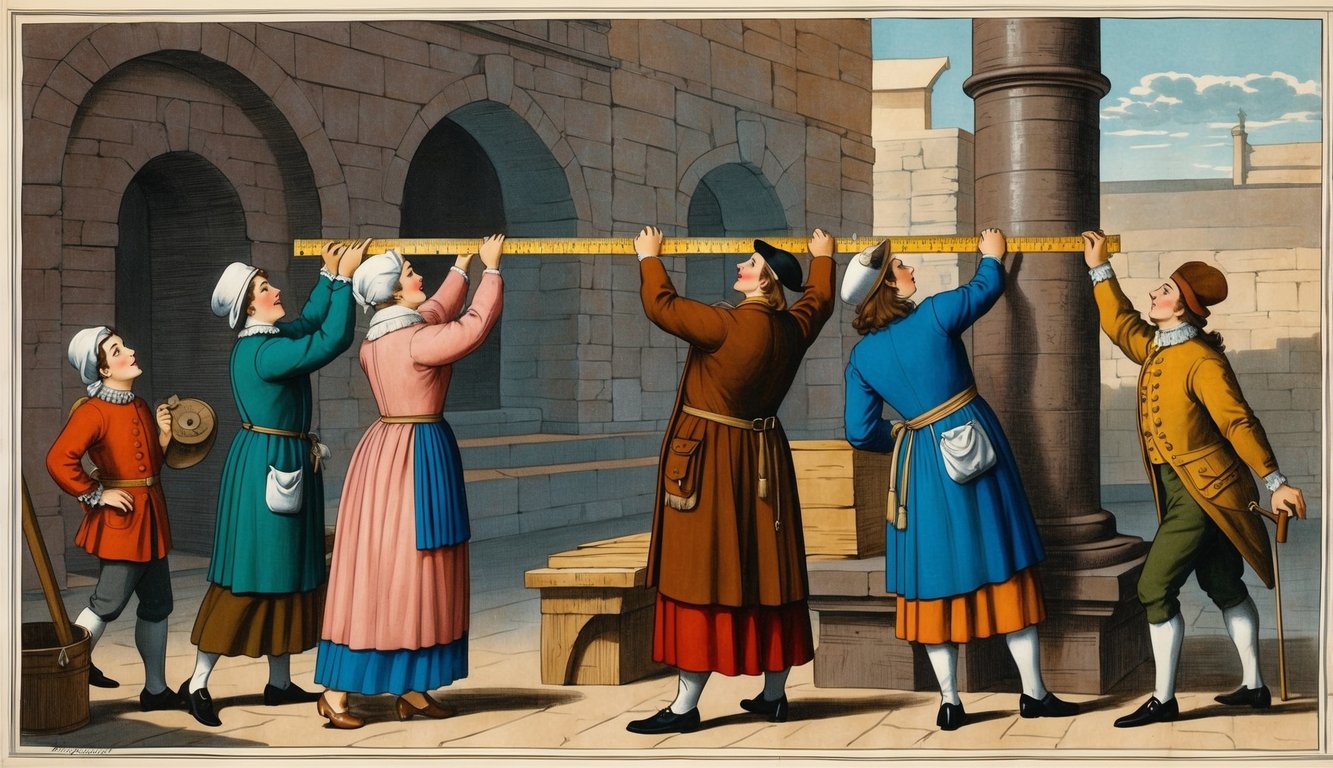Don’t Miss Out On This Unique Astrological Opportunity
Are you tired of spinning your wheels and getting nowhere? Simply put, you’re out of sync: you’re out of alignment with your astral configuration.
But: there’s a kind of map that can help you reclaim your alignment. Think of it as your own personal blueprint to success and happiness: a blueprint that will help you live your most amazing life.
Get started here.
Many people are curious about how tall Jesus was.
Though the Bible does not give an exact height, various historical and cultural contexts provide some clues.
It is commonly suggested that Jesus was likely around average height for men of his time, estimated to be about 5 feet 5 inches tall.
This estimate is based on historical records and archaeological findings regarding the average height of men living in Judea during the 1st century.
These estimates come from examining skeletal remains and written descriptions from that era.
Though these insights can offer some guidance, they do not provide a definitive answer.
Over time, cultural depictions have varied widely, often influenced by the artistic and theological perspectives of different periods and places.
Paintings and sculptures of Jesus have depicted him in various ways, reflecting how communities viewed him.
Beyond his physical appearance, people are also interested in the theological significance of Jesus’ identity.
His role as a spiritual leader has been more important than any discussion about his height.
Understanding these nuances can offer deeper insight into how Jesus has been perceived throughout history.
Key Takeaways
- Jesus’ height is estimated to be about 5 feet 5 inches.
- Different cultures have depicted Jesus differently over time.
- Jesus’ spiritual role has a lasting impact beyond physical appearance.
Historical Context and Records

In understanding the historical context of Jesus, it is helpful to examine the geopolitical state of Judea and the society in which he lived.
The political dynamics and various religious groups present in Judea during the 1st century reveal much about the environment that influenced Jesus and his teachings.
Roman rule over Judea brought both political tension and cultural exchanges, shaping the experiences of those living in the region.
Various sects, such as the Pharisees, Sadducees, and Zealots, played significant roles in religious and societal debates, often influencing public perceptions of new teachings.
Scholars frequently discuss what year was Jesus born to better understand the historical and political landscape that framed his early life and ministry.
Geopolitical State of Judea
During the 1st century, Judea was under Roman rule.
The Romans had control over the region, which is part of modern-day Palestine and Israel.
This occupation influenced the daily lives of Jewish people, including political tensions and conflicts.
Judea was a critical region for the Romans due to its location.
It connected several trade routes, making it a vital area for commerce and military passage.
This added pressure on local governance as the Romans imposed their own administrative systems, taxes, and laws.
Jewish leaders worked to balance Roman demands with the needs of their own people.
Roman governors, such as Pontius Pilate, played pivotal roles in the administration and sometimes conflicted with Jewish authority, influencing the religious dynamics described in the Gospels.
Judean Society and Religious Groups
Judean society in the time of Jesus was diverse and vibrant.
Various religious groups, including Pharisees, Sadducees, Essenes, and Zealots, held significant influence.
These groups often had differing beliefs about Judaism.
Pharisees emphasized strict adherence to oral and written law, while Sadducees, mainly priests and aristocrats, held control of the temple in Jerusalem.
The Essenes are believed to have led an ascetic lifestyle, separating themselves from society.
Meanwhile, the Zealots actively resisted Roman rule, sometimes violently.
This diverse social landscape is mentioned throughout the New Testament, as Jesus interacted with many groups.
Each group contributed to the broader understanding of Jewish life and religion during this period in Judea.
These interactions influenced the spread of Jesus’s message and how he was perceived as either a prophet or the Messiah by his followers and disciples.
Physical Appearance in Historical Texts

When exploring the physical appearance of Jesus in historical texts, you encounter varied descriptions.
Biblical texts offer limited details, while scholars and researchers provide insights from anthropology and forensic studies.
Physical Descriptions in the Gospels
The Gospels give minimal information about Jesus’s appearance.
They do not specify his height, but as a Galilean Jew, Jesus likely shared features common in that region during his time.
Descriptions often suggest he had olive-brown skin, typical of people living in the Middle East.
Some interpretations propose he might have had black, curly or straight hair and a beard, given cultural norms.
Clothing mentioned in texts includes a tunic, cloak, and sandals, fitting for a carpenter.
Roman depictions in later centuries contributed to our modern image of Jesus, often showing him with long hair and a serene expression.
Anthropological and Forensic Research
Anthropological and forensic studies provide further insight into Jesus’s likely appearance.
Scholars like Joan Taylor use archaeological findings and historical analysis.
They suggest Jesus had characteristics shared by Jewish men at that time.
Richard Neave, a forensic anthropologist, reconstructed a face based on skulls from the region.
This shows a man with a broad face, olive-brown skin, and dark, curly hair.
These reconstructions help revise the traditional image of Jesus as white and long-haired, painting a picture more consistent with historical and regional characteristics.
These studies highlight the gap between traditional depictions and historically accurate features, offering a clearer understanding despite the lack of direct biblical descriptions.
Cultural Depictions and Their Evolution
The portrayal of Jesus has changed significantly through the ages.
Early Christian art highlighted symbolism over details, while the Middle Ages and Renaissance brought more realistic representations.
In contemporary times, portrayals are diverse, reflecting various cultural and theological viewpoints.
Early Christian Art and Mosaics
In the early days of Christianity, depictions of Jesus often emphasized symbolic imagery rather than realistic features.
Mosaics from this period, particularly in regions like Palestine and the Middle East, showcased Jesus in a stylized form.
Artists focused on symbolic elements to convey his religious significance, such as the cross representing the crucifixion.
Jesus was often shown as the Good Shepherd, a youthful figure carrying a lamb, symbolizing guidance and protection.
These early artistic depictions aimed to convey theological messages, focusing on Jesus as the Son of God rather than on physical details.
The use of mosaics allowed for vibrant and durable artworks, which played a critical role in conveying Christian stories and teachings to believers.
Medieval and Renaissance Periods
The Medieval and Renaissance periods marked a shift toward more realistic portrayals of Jesus.
Artists began to emphasize the human aspects of Jesus, influenced by changes in theological perspectives and artistic techniques.
The crucifixion and resurrection scenes became prominent, emphasizing both his humanity and divinity.
During this time, European art flourished, with significant works emerging from Italy and the surrounding regions.
The use of perspective, naturalism, and chiaroscuro highlighted the emotional depth and physical suffering of Jesus.
Art from this period often depicted events from the New Testament with greater historical and cultural context, thus deepening the connection between viewers and the divine narratives.
Modern Interpretations
Contemporary depictions of Jesus vary widely across cultures and artistic mediums, highlighting a blend of traditional elements with modern insights.
Artists today often explore the intersection of Jesus’ human and divine nature, reflecting on themes of social justice, peace, and compassion.
These modern interpretations sometimes challenge traditional views, encouraging new conversations about his role in today’s world.
In film, literature, and visual arts, Jesus has been portrayed in diverse ways.
Some representations focus on his Middle Eastern origins, while others adapt his image to resonate with different cultural contexts and artistic styles.
This ongoing evolution mirrors the dynamic nature of Christianity and its place in contemporary society.
Theological Significance of Jesus’ Identity

The identity of Jesus holds great importance in Christian theology and shapes many spiritual practices.
This discussion will look at Jesus’ role as a central figure in Christianity and how his life and teachings influence worship and prayer today.
Jesus’ Role in Christian Theology
Jesus is central to Christian theology as he is seen as both the Son of God and the Messiah.
This dual identity reflects his role as a bridge between humanity and God, offering salvation and hope through his life and resurrection.
Biblical scholars often examine how Jesus’ teachings and actions fulfilled prophecies from the Old Testament, such as those of Moses and David.
In the context of Second Temple Judaism, Jesus redefined religious expectations.
His title as the “Good Shepherd” signifies his guidance and protection of believers.
Over time, figures like Paul expanded on Jesus’ theological significance, emphasizing faith in him as the path to redemption.
Influence on Christian Spiritual Practice
Jesus’ teachings and example greatly influence Christian spiritual practices.
His life exemplifies virtues that many Christians strive to emulate, such as compassion and humility.
Practices like prayer and worship are rooted in the belief of Jesus’ divine role and his connection to God and the Holy Spirit.
The roles of key figures, such as Mary, Joseph, and John the Baptist, surrounding Jesus’ birth and ministry are celebrated in Christian rituals.
The emphasis is on how believers can draw closer to God by following Jesus’ example.
In cities like Jerusalem, pilgrimages retrace Jesus’ steps, fostering a deeper connection to his teachings.
These spiritual practices reinforce the theological significance of Jesus, helping followers live out their faith in meaningful ways.
Frequently Asked Questions
In this section, you will find information about Jesus’ estimated height and how historical data, artifacts, and biblical descriptions contribute to our knowledge.
Discover how scholars approach this intriguing topic.
What was the estimated height of Jesus based on historical data?
Most historians suggest that Jesus might have been around 5 feet 5 inches tall.
This estimate is based on archaeological findings and skeletal remains from the same period in ancient Judea.
Can the Shroud of Turin provide clues about Jesus’ stature?
The Shroud of Turin is believed by some to bear the image of Jesus.
It depicts a man around 5 feet 7 inches tall.
While debated, this artifact offers some potential insight into Jesus’ stature.
What was the average height of a man during the time of Jesus?
In the ancient Near East, the average height for males was approximately 5 feet 5 inches.
This suggests that if Jesus were in this range, he would have been of average height for his time.
How do biblical descriptions contribute to understanding Jesus’ physical appearance?
The Bible does not give detailed descriptions of Jesus’ appearance.
However, his Jewish heritage and the customs of the time provide context, suggesting he had a Middle Eastern complexion and features.
Are there historical artifacts that give insight into Jesus’ height?
Artifacts like ancient bones and written records from the period help estimate the average height of people during that time.
These findings indirectly support height assumptions about historical figures, including Jesus.
What methods do scholars use to estimate the physical dimensions of historical figures like Jesus?
Scholars use a variety of methods.
These include examining archaeological sites, studying ancient skeletons, and referencing historical texts.
These approaches help create a more informed speculation about the physical attributes of historical figures.



